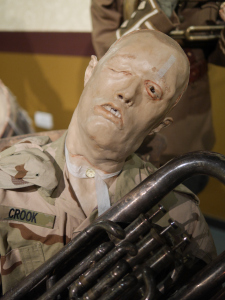*Warning graphic images of some reconstructions of severe facial injuries are below*
Yesterday on the 2nd of December I attended a talk by Eleanor Crook on her exhibition “And the Band Played On” at the Florence Nightingale Museum. The exhibition features five life sized wax models which depicts five soldiers with facial injuries from the Crimean War to the present day.
Before I begin, a full disclaimer, I was a Museum Assistant at the Florence Nightingale Museum and helped set up the exhibition. Having seen the sculptures I have to say they are very graphic and very moving. It’s difficult to look at them and not have an emotional reaction.
Eleanor started the lecture by telling the story of how she got into the subject. Her involvement with these ideas started with the story of her great uncle Frank who after receiving a severe facial injury in combat dropped off the family radar. No one knew what had happened to him until a very distantly related family historian discovered he had lived in a nursing home from the time of his disappearance until 1983. She later became interested in anatomical sculpting with would later tie in with this.
One of her first sculptures heading in this direction was one of an ex-boyfriend, coping with the rejection by sculpted with his “trousers” or rather skin falling down. “He’s actually very nice and didn’t deserve it at all” she said “I think if he saw the piece he’d realised he made the right decision.”
That piece and many of her others can be seen here: http://www.eleanorcrook.com/gallery/sculpture/
Eleanor then went on to describe the history of reconstructive surgery which can be traced back to the Romans and Greeks and was certainly present in this country as far back as the 11th Century. However she decided to start with the development of anaesthetics in the 1830s and 1840s which allowed for extended surgery and coincided with advent of photography.
This advance was put to its first significant test in the American Civil War. Eleanor said seeing facial sculptures from that conflict, like the ones below showed her the reality of war injuries much better than photographs did. She explained how the 3D models showed the unnatural caverns that the wounds would open on the human face, something she tried to show in her own sculptures.
Starting as merely attempts at wound closure to give those injured the semblance of a “wall” on their face, techniques were pioneered by Harold Gillys and his “guinea pigs”. The one I found most interesting was Tubed Pedicles. Before the dawn of microsurgery skin grafts needed to be connected from one part of the body to the other as without blood supply and lymphatic drainage the new skin will either wither and die or swell up. Thus this meant that the skin had to be physically connected to its original location to allow for the capillaries in the skin to grow together.
Perhaps most incredibly the tubed pedicles would know what to grow into. On the outside of the mouth they would grow into regular skin but if connected to the inside of the mouth it would grow mucus membrane.
This sculpture represented a Second World War pilot, a group that were disproportionately affected by burns as their cockpits were positioned dangerously close to fuel tanks.
Eleanor ended the lecture on a positive note. She said she chose the theme of a marching band to represent the fellowship between the men who had been injured in this way and their gameness to carry on.
Her sculpture of an injured American veteran shows the possibility of facial transplants in the future. If you look close enough to can see the contrast between the ginger fair on the man’s own skin and the black hair on the transplanted face. She said she hoped to convey the mixed emotions of fear, bewilderment and hope that the man would be feeling. Personally I think she succeeded, not just with this sculpture but the whole exhibition.
For more on the exhibition which is open till the 22nd of December please visit the blog at https://andthebandplayedonblog.wordpress.com/ which is being run by two interns Rhiannon and Morgan.







Brutal.